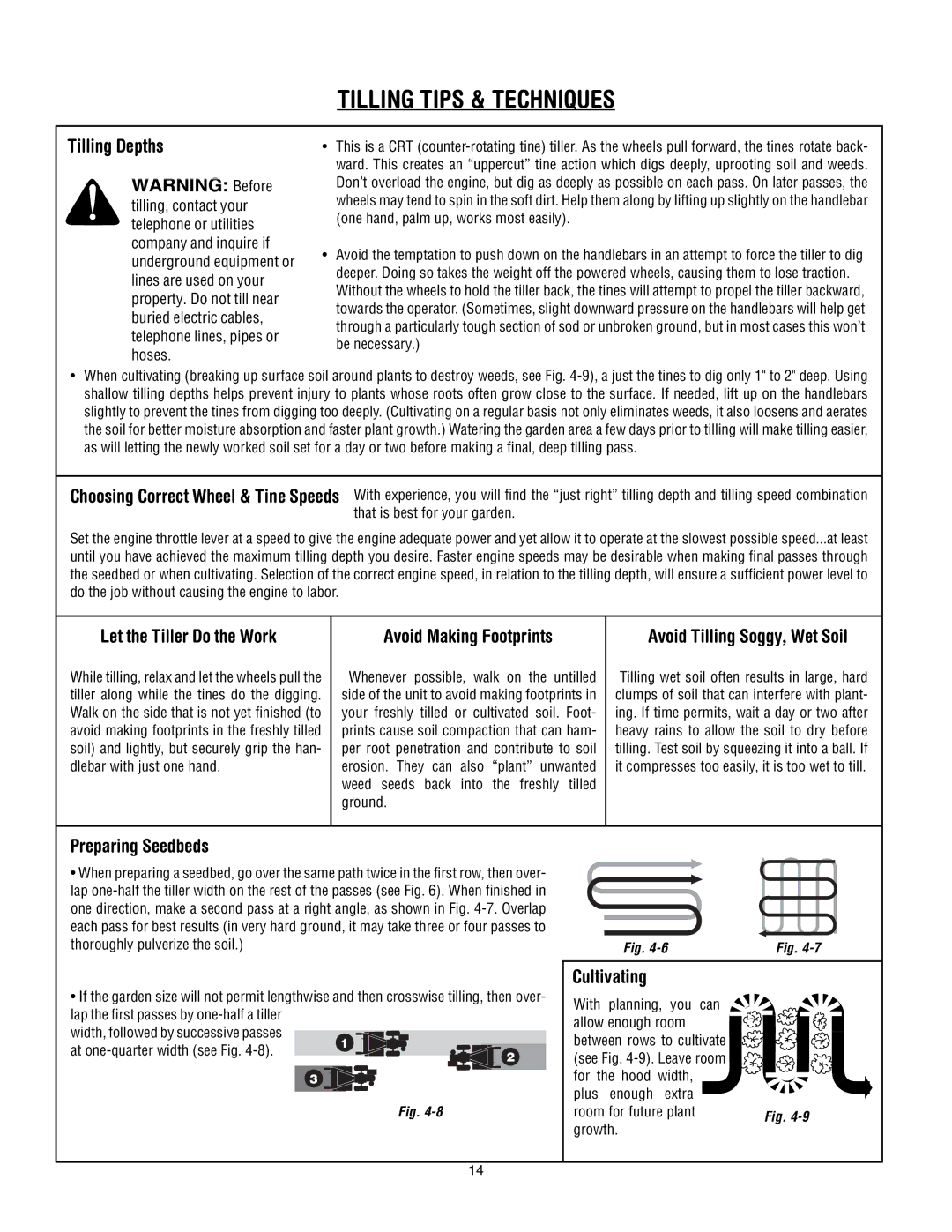
TILLING TIPS & TECHNIQUES
Tilling Depths
WARNING: Before
tilling, contact your telephone or utilities company and inquire if underground equipment or lines are used on your property. Do not till near buried electric cables, telephone lines, pipes or hoses.
•This is a CRT
•Avoid the temptation to push down on the handlebars in an attempt to force the tiller to dig deeper. Doing so takes the weight off the powered wheels, causing them to lose traction. Without the wheels to hold the tiller back, the tines will attempt to propel the tiller backward, towards the operator. (Sometimes, slight downward pressure on the handlebars will help get through a particularly tough section of sod or unbroken ground, but in most cases this won’t be necessary.)
•When cultivating (breaking up surface soil around plants to destroy weeds, see Fig.
Choosing Correct Wheel & Tine Speeds With experience, you will find the “just right” tilling depth and tilling speed combination that is best for your garden.
Set the engine throttle lever at a speed to give the engine adequate power and yet allow it to operate at the slowest possible speed...at least until you have achieved the maximum tilling depth you desire. Faster engine speeds may be desirable when making final passes through the seedbed or when cultivating. Selection of the correct engine speed, in relation to the tilling depth, will ensure a sufficient power level to do the job without causing the engine to labor.
Let the Tiller Do the Work
While tilling, relax and let the wheels pull the tiller along while the tines do the digging. Walk on the side that is not yet finished (to avoid making footprints in the freshly tilled soil) and lightly, but securely grip the han- dlebar with just one hand.
Avoid Making Footprints
Whenever possible, walk on the untilled side of the unit to avoid making footprints in your freshly tilled or cultivated soil. Foot- prints cause soil compaction that can ham- per root penetration and contribute to soil erosion. They can also “plant” unwanted weed seeds back into the freshly tilled ground.
Avoid Tilling Soggy, Wet Soil
Tilling wet soil often results in large, hard clumps of soil that can interfere with plant- ing. If time permits, wait a day or two after heavy rains to allow the soil to dry before tilling. Test soil by squeezing it into a ball. If it compresses too easily, it is too wet to till.
Preparing Seedbeds
•When preparing a seedbed, go over the same path twice in the first row, then over- lap
•If the garden size will not permit lengthwise and then crosswise tilling, then over- lap the first passes by
width, followed by successive passes | 1 |
|
|
|
| |
|
|
|
| |||
at |
|
|
| 2 | ||
|
|
|
|
|
| |
| 3 |
|
|
|
|
|
|
|
|
|
|
| |
|
|
|
| Fig. | ||
|
|
|
| |||
Fig. 4-6 Fig. 4-7
Cultivating
With | planning, | you can |
|
|
|
|
|
|
|
|
|
|
|
allow enough room |
|
|
|
|
|
|
|
|
|
|
| ||
|
|
|
|
|
|
|
|
|
|
| |||
|
|
|
|
|
|
|
|
|
|
| |||
|
|
|
|
|
|
|
|
|
|
| |||
between rows to cultivate |
|
|
|
|
|
|
|
|
|
|
| ||
(see Fig. |
|
|
|
|
|
|
|
|
|
|
| ||
for the hood width, |
|
|
|
|
|
|
|
|
|
|
| ||
|
|
|
|
|
|
|
|
|
|
| |||
|
|
|
|
|
|
|
|
|
|
| |||
plus | enough | extra |
|
|
|
|
|
|
|
|
|
|
|
|
|
|
|
|
|
|
|
|
|
| |||
room for future plant |
|
| Fig. | ||||||||||
|
|
|
|
| |||||||||
growth.
14
